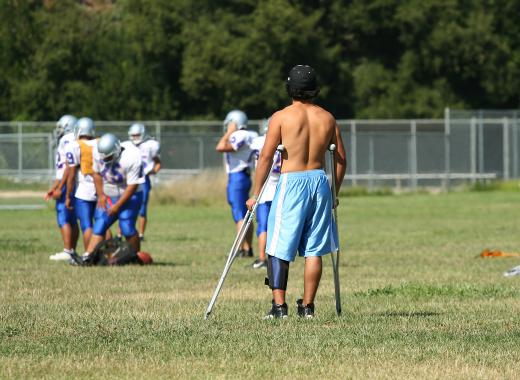At Sports&Hobbies, we're committed to delivering accurate, trustworthy information. Our expert-authored content is rigorously fact-checked and sourced from credible authorities. Discover how we uphold the highest standards in providing you with reliable knowledge.
What is a Redshirt Freshman?
When a promising high school athlete accepts a college's offer of an athletic scholarship, the arrangement usually covers the recipient's expenses for four academic years, the traditional amount of time required to earn an undergraduate degree. Under existing collegiate sports rules, however, an athlete on scholarship can decide to sit out for a season under certain circumstances. Such a student athlete, although an academic sophomore, would be designated a redshirt freshman in order to distinguish him or her from a true freshman, a student athlete actually in his or her first academic year of college. Someone with this designation cannot participate in any sanctioned competition, but he or she can still attend practices and wear a uniform while officially benched.
Sometimes, a first year athlete may need some time away from active competition in order to gain strength or become better conditioned for the demands of the sport. There may also be a sufficient number of seasoned players for a particular position, so a true freshman with little to contribute may elect to sit out until the following season. This would allow the athlete to concentrate on his or her academic goals while still remaining eligible for a four-year athletic scholarship. The four years of tuition and expenses covered by the scholarship would essentially be stretched over a five year period. This practice does create two unusual circumstances; a redshirt freshman and a fifth-year senior.

An athletic scholarship recipient can also become a redshirt freshman for medical reasons. If he or she becomes seriously injured during a season, an active player can be considered a medical redshirt, as long as a governing body recognizes the injury as being season-ending. A medical redshirt still receives all the academic benefits of the original scholarship while in recovery, and may also be granted an extension beyond the initial four years. Under these conditions, however, it is vital that the athlete avoid any activity that could be construed as active competition. A football player with this designation, for example, cannot participate in a single play during a game.

A student athlete may also agree to this status in order to learn a complicated playbook or shadow more experienced players before suiting up for competition. Sometimes, an inexperienced athlete can start a season in this way but later have that designation removed in order to compete legally. A redshirted player is not automatically excluded from future participation during that academic year, since the coach does not have to report a player's status until the season is over. If a redshirt freshman does participate in a sanctioned competition, however, his or her scholarship will be charged for that entire academic year. This is why many injured athletes remain benched or sidelined even if they have regained much of their ability to compete by the end of the season.

There are several theories about the origin of the term, but the most common one suggests that ineligible players on college football teams were often required to wear red jerseys or shirts during practices and games. This practice made it far less likely for a coach to send a clearly ineligible player into the competition.
AS FEATURED ON:
AS FEATURED ON:














Discuss this Article
Post your comments